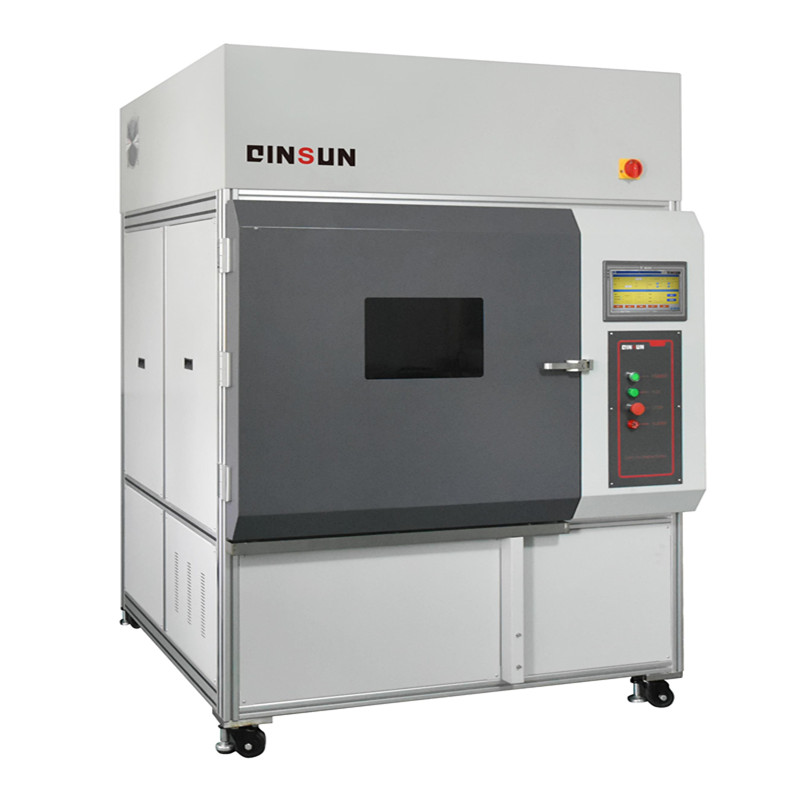Xenon Lamp Aging Test Machine GB/T 8427: European and American Exposure Conditions
The new version of GB/T 8427, titled "Textile — Tests for Color Fastness to Artificial Light: Xenon Arc Fading Lamp Test," is a revision of GB/T 8427-1998, incorporating the ISO 105 B02:1994 standard and its amendments. In the textile industry, GB/T 8427 is a widely adopted standard for testing lightfastness. The core principle involves using a xenon lamp light source to simulate the effect of atmospheric conditions on textile colors, accelerated by light and other factors. The xenon lamp aging test chamber serves as the experimental equipment for this purpose.
Shanghai Qianshi Precision Electromechanical Technology Co., Ltd., founded in 2012, specializes in the research, development, design, and manufacture of textile testing instruments. It provides textile testing equipment and services to academic research institutions and testing laboratories. Shanghai Qianshi is currently one of China's most competitive manufacturers of textile testing instruments, with an R&D team comprising experienced engineers. We are dedicated to serving our customers with utmost sincerity and strive to promote technological innovation in textile testing instruments.
- Blue Wool Standards:
Section 6.1 of the new GB/T 8427 standard specifies that European exposure conditions utilize blue wool standard samples 1 to 8, as outlined in Section 4.1.1. Similarly, Section 6.2 indicates that American exposure conditions employ blue wool standard samples L2 to L9, detailed in Section 4.1.2. While samples 1 to 8 and L2 to L9 share similarities, it's crucial to note that the fading characteristics of these two sets of blue wool standards may differ. Consequently, the results obtained from them are not interchangeable.

- Irradiance Requirements:
In the "4.2.1.1 Air-cooled xenon arc equipment" section, the standard stipulates that the filter (Window IR filter) must be placed between the light source and the sample/blue wool standard to stabilize the attenuation of the ultraviolet spectrum. The transmittance of the filter glass should be at least 90% between 380nm and 750nm, dropping to 0 between 310nm and 320nm. Additionally, the infrared radiation in the xenon arc spectrum must be consistently reduced.
The "4.2.1.2 Water-cooled xenon arc equipment" section describes two filters, both requiring inner and outer filter glasses for cooling water circulation. These filters, placed between the light source and the sample/blue wool standard, stabilize the attenuation of the ultraviolet and part of the infrared spectrum. One filter system corresponds to European exposure conditions, using IR filters for both inner and outer glasses, combined with the window glass cover to form a Window IR filter. The transmittance of this filter system should be at least 90% between 380nm and 750nm, dropping to 0 between 310nm and 320nm. The other filter system is for American exposure conditions, with the inner filter made of borosilicate glass and the outer filter of transparent soda-lime glass (Window B/SL filter), blocking lower wavelength spectral radiation and making the spectral radiation reaching the sample roughly equivalent to that passing through ordinary window glass.
The light intensity cutoff points and appropriate standards for the Window IR filter and Window B/SL filter are outlined in Table 1 below.
| Light intensity cutoff point | Use occasions | |
| Window B/LS | 300nm | Recommended for AATCC (e.g. TM16-3); meets most ISO and ASTM requirements |
| Window IR | 310nm | Reduce heat to achieve lower exposure temperature, suitable for ISO105 B02 "European conditions" not related to ASTM requirements |
However, irrespective of whether the xenon lamp equipment is air-cooled or water-cooled, the irradiance measured by the irradiance meter is recommended to be 42W/m² (wavelength 300-400nm) or 1.10W/m² (wavelength 420nm).
- Temperature and Humidity Requirements:
Under European exposure conditions (Section 6.1), the standard specifies medium effective humidity, with the color fastness of the humidity control standard sample at level 5 and the black standard temperature set at 50°C.
For American exposure conditions (Section 6.2), the requirements include a blackboard temperature of (63±1)°C, a relative humidity in the test chamber of (30±5)%, low effective humidity, and the color fastness of the humidity control standard sample ranging from 6 to 7.
- Comprehensive Equipment Requirements:
To meet both European and American exposure conditions specified in GB/T 8427, the test equipment must be equipped with blue wool standards 1 to 8 and L2 to L9, Window IR filter and Window B/SL filter, a blackboard thermometer, and a black standard thermometer. Specifically, the European and American exposure conditions are conducted according to the parameters outlined in Table 2.
| European Exposure Conditions | U.S. Exposure Conditions | |
|---|---|---|
| Blue Wool Standard | Blue Wool Standard 1~8 | Blue Wool Standard L2~L9 |
| Filter | Window IR | Window B/S |
| Irradiance | 1.10W/m²@420nm or 42W/m²@300-400nm | 1.10W/m²@420nm or 42W/m²@300-400nm |
| Thermometer | Black Standard Thermometer | Blackboard Thermometer |
| Temperature | Black Standard Temperature Max 50°C | Blackboard Temperature 63°C |
| Humidity | Moderate Effective Humidity | Relative Humidity 30% |
Table 2 provides the specific test parameters for both European and American exposure conditions.
In summary, the new version of the GB/T 8427 standard encompasses two distinct test conditions: European and American exposure conditions, commonly referred to as European standards and American standards. These two exposure methods are compared in terms of blue wool standards, filters, irradiance, temperature, and humidity.
2024-12-30 11:41
- Related News
Automatic Cross-Hatch Tester | PV 3952, Ford BN 108-03,GM N 14688 Compliant
Multi-Finger Scratch/Mar Tester | Automotive Plastics & Interior Materials T
Dental Material Color Stability Tester | ISO 4049 / YY 0270 / ASTM G155 Complian
Masks Bacterial Filtration Efficiency (BFE) Tester | YY 0469 / ASTM F2100 / BS E
Smoke Density Tester | ASTM E662 / ISO 5659-2 Compliant
Dry Microbial Penetration Resistance Tester | ISO 22612 / YY/T 0506.5
Dry Fallen Wadding Tester — YY/T 0506.6 | ISO 9073-10 | EN 13795-2
Fogging Tester | Automotive Interior Volatile Fogging Test System
